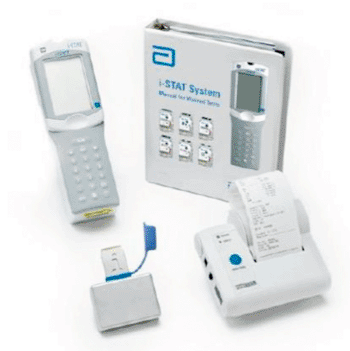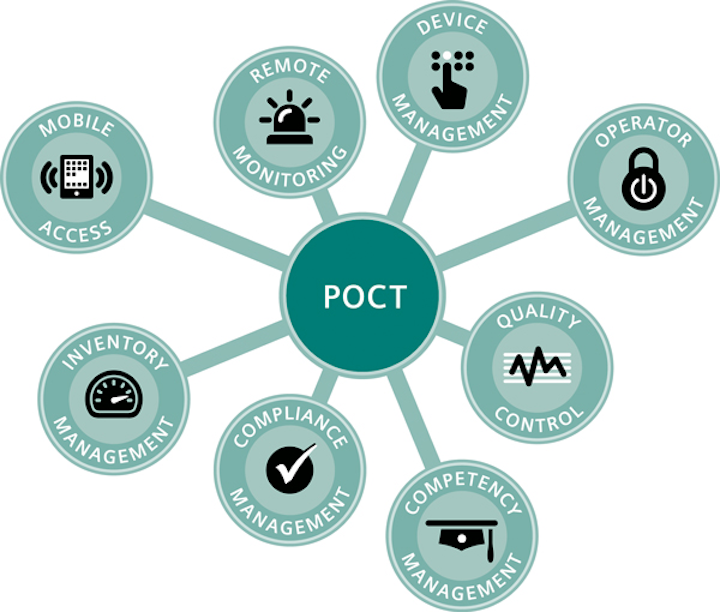POCT- The Rapid Way of Diagnosis
Clinical laboratory results play a vital role in emergency care, and more so today. A diagnostic test allows physicians to provide treatment in real-time. POCT or Point of Care Testing is a diagnostic test performed at the ‘point of care’ by a healthcare worker. It plays a pivotal role in monitoring diagnosis, treatment response, and prognosis of many diseases. POCT is a low cost, highly mobile testing that helps in decision making and gives rapid results (within 10-15 minutes). This significantly reduces the length of hospital stay as well as the time lag between diagnosis and beginning of treatment. POCT is also known as Near Patient testing, Bedside testing, and Patient focus testing. Clinical laboratories today are primarily dependent upon culture-based techniques that have long turnaround times. Due to lesser time between testing and results, POCT is functional in primary health care, operation theatres, delivery room, and emergency. However, validation and quality assurance are essential for POCT testing. Did you know that the first POCT was reported in Egypt in 1550 B.C for Diabetes Mellitus to diagnose glucosuria in Patients? The concept of POCT has been in use for years for the diagnosis of STDs like Trichomonas vaginalis, Gonorrhea, Yeast infections, and bacterial vaginosis. Similarly, Rapid Dipstick for urine analysis for the diagnosis of Urinary tract infection.
Types of POCT
POCT differs in size and we can categorize it as Handheld, Portable, and Transportable based on the format used. We can also differentiate POCT based on the method of testing, the type of Chemistry used for measurement. For example, for glucose testing, glucometers are categorized by absorbance photometry, electrochemical biosensor, and reflectance Photometry. While many believe POCT is used in detecting infectious diseases, it will surprise you to know its growing use in other specialities as well.
Use of POCT Devices in Cardiology

Image Source: https://www.labmedica.com/clinical-chemistry/articles/294748486/point-of-care-device-compared-for-cardiac-troponin-assay.html
The most common POCT test is done in cardiology is for Troponin I. Troponin is the biological analyte that is detectable in the bloodstream. There are 3 types of troponins- Troponin C, Troponin I, Troponin I. Since troponin T, and troponin I are cardiac-specific, they can help in the identification of cardiac muscle damage. Troponin is present in small quantities in the blood. Its levels are elevated during myocardial damage. It is highly specific and its testing measures cardiac-specific troponin level that helps in the detection of any form of cardiac injury. This test is required when a patient has signs and symptoms of myocardial infarction, such as chest pain, dyspnea, pain in the left side of the shoulder, jaw, and neck. More the damage more is the troponin concentration in blood. Due to the reasons mentioned above, the primary use of the troponin test is the determination of myocardial infarction. It is a high sensitivity test and has been FDA approved in 2017. The test is useful in high-risk angina, even though there are no obvious cardiovascular disease symptoms. In the case of Myocardial infarction, the level of Troponin T and Troponin I are elevated in blood within 3-4 hrs. After the myocardial injury, it will remain elevated for up to 14 days. Troponin I is a quick and reliable test. It is useful in that it gives results within 10 minutes. The Troponin I test device gives accuracy around 98.5 % device has indicator markers on it. Normal range Troponin I- 0.04ng /mL. For Example – SD BIOLINE TROPONIN I from Abbott Laboratories Provides lab-quality results in minutes. It is a qualitative method and this device measures Troponin I from whole blood, serum, and plasma.
Use of POCT In Infectious Diseases
Currently, in the global Pandemic, POCT gained great practical importance for the diagnosis of COVID-19 and other infectious diseases like pneumonia, influenza, and legionella. POCT is highly beneficial for diagnosing infectious diseases. POCT for influenza was developed to start early treatment(within 48 hrs). Currently, the Influenza test gives 70-100% of sensitivity and 96% of Specificity. For COVID-19, WHO has approved POCT rapid diagnostic kits that detect viral antigens. To perform this test, a sample is taken from the respiratory tract. Indian scientists developed a paper striped test at a low cost for the detection of nCov2019, which detects the virus within hours. POCT is commonly used to diagnose diseases like malaria, influenza, HIV, syphilis, dengue, cholera, rotavirus, HAV, Group A Streptococcal pharyngitis.
Benefits of using POCT

Image Source: https://www.mlo-online.com/continuing-education/article/13009495/preanalytical-errors-and-critical-variables-in-poct
Point of Care Testing has become more relevant in today’s world and time due to the rising number of lifestyle and infectious diseases. It has a lot of benefits: POCT is user friendly and highly productive It provides valid information for rapid triage. It is the most efficient and effective care that provides rapid results as per patients’ requirement POCT is portable and these test can be easily transported around the globe as required They are as accurate as lab tests POCT reduces the contamination of specimens and misreporting patients’ results. This means that POCT reduces preanalytic and post-analytic testing errors These tests are affordable due to minimal infrastructure required for performing the test POCT eliminates blood collection tubes by reducing blood specimen volume It also reduces storage, data management, and connectivity issues The main highlight of POCT is the ‘Patient care’ approach to healthcare.
POCT and Its Benefits for Indian Healthcare
It is a well-known fact that healthcare in India has immense potential and is, in fact, a $125 billion company. POCT in rural settings can act as a key driver in the growth of the industry in these regions. One of the biggest challenges of rural healthcare in India is poor access to healthcare services and accurate, affordable diagnostics. These challenges can be overcome by using POCT as it enables diagnosis of patients in a primary healthcare centre, a physician’s office, at home, ambulance in a field. Since the results of POCT are available quickly, enables doctors to make quick decisions, helps in early diagnosis of diseases and subsequent prompt treatments. POCT isn’t all about treatment as it helps shifts focus to predictive medicine and helps reduce overall healthcare costs to patients. This is particularly useful for a country like India who has a major chunk of its population in the rural poor or urban poor areas. In very rural parts of the country with no secondary and tertiary healthcare centres, POCT can be used to enhance telemedicine. While POCT is not an alternative to building better health infrastructure in countries like India, it is a way forward when it comes to technological advancement and integration with the current infrastructure.